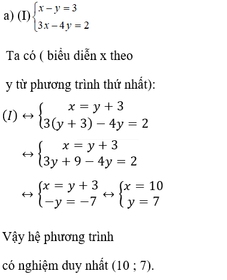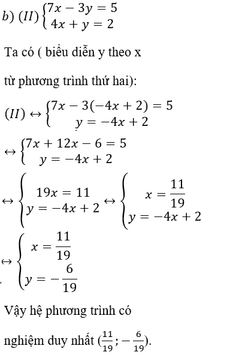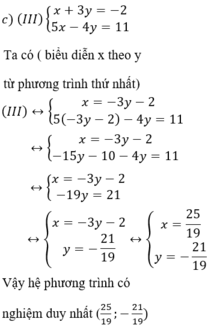
Hãy nhập câu hỏi của bạn vào đây, nếu là tài khoản VIP, bạn sẽ được ưu tiên trả lời.


Cách 1

Từ (1) rút ra được y = x – 3
Thế vào phương trình (2) ta được:
3x – 4.(x – 3) = 2 ⇔ 3x – 4x + 12 = 2 ⇔ x = 10
Từ x = 10 ⇒ y = x – 3 = 7.
Vậy hệ phương trình có nghiệm duy nhất (10 ; 7).

Từ (2) rút ra được y = -4x + 2.
Thế y = -4x + 2 vào phương trình (1) ta được :
7x – 3.(-4x+2) = 5 ⇔ 7x + 12x – 6 = 5 ⇔ 19x = 11 ⇔ x= 11/19

Vậy hệ phương trình có nghiệm duy nhất ( 11/19;-6/19)

Từ (1) rút x theo y ta được: x = -3y – 2
Thế x = -3y – 2 vào phương trình (2) ta được :
5.(-3y – 2) – 4y = 11 ⇔ -15y – 10 – 4y = 11 ⇔ -19y = 21 ⇔ y = - 21/19

Vậy hệ phương trình có nghiệm duy nhất ( 25/19; -21/19)
Cách 2



Kiến thức áp dụng
Giải hệ phương trình  ta làm như sau:
ta làm như sau:
Bước 1: Từ một phương trình (coi là phương trình thứ nhất), ta biểu diễn x theo y (hoặc y theo x) ta được phương trình (*). Sau đó, ta thế (*) vào phương trình thứ hai để được một phương trình mới ( chỉ còn một ẩn)..
Bước 2: Dùng phương trình mới ấy thay thế cho phương trình thứ hai, phương trình (*) thay thế cho phương trình thứ nhất của hệ ta được hệ phương trình mới tương đương ..
Bước 3: Giải hệ phương trình mới ta tìm được nghiệm của hệ phương trình.

\(1,3x+2y=7\\ \Leftrightarrow2y=7-3x\left(1\right)\)
Vì \(2y⋮2\)
\(\Leftrightarrow3x-7⋮2\\ \Leftrightarrow3x-9⋮2\\ \Leftrightarrow3\left(x-3\right)⋮2\\ \Leftrightarrow x-3⋮2\\ \Leftrightarrow x.lẻ\)
Đặt \(x=2k+1\left(k\in Z\right)\)
Thay vào (1), ta được :
\(\left(1\right)\Leftrightarrow2y=3\left(2k+1\right)-7\\ \Leftrightarrow2y=6k+3-7\\ \Leftrightarrow2y=6k-4\\ \Leftrightarrow y=3k-2\)
Vậy \(x=2k+1;y=3k-2\left(k\in Z\right)\)
\(2,C_1:\left\{{}\begin{matrix}-2x+y=1\\4x+5y=3\end{matrix}\right.\Leftrightarrow\left\{{}\begin{matrix}-4x+2y=2\\4x+5y=3\end{matrix}\right.\\ \Leftrightarrow\left\{{}\begin{matrix}4x+5y=2\\7y=5\end{matrix}\right.\Leftrightarrow\left\{{}\begin{matrix}x=-\dfrac{1}{7}\\y=\dfrac{5}{7}\end{matrix}\right.\\ C_2:\left\{{}\begin{matrix}-2x+y=1\\4x+5y=3\end{matrix}\right.\Leftrightarrow\left\{{}\begin{matrix}y=1+2x\\4x+5y=3\end{matrix}\right.\Leftrightarrow4x+5+10x=3\\ \Leftrightarrow x=-\dfrac{1}{7}\Leftrightarrow y=1-\dfrac{2}{7}=\dfrac{5}{7}\)

a) Thay m=2 vào hpt, ta có \(\hept{\begin{cases}-x+2y=6\\6x-y=-4\end{cases}}\)
\(\Leftrightarrow\hept{\begin{cases}y=6x+4\\-x+12x+8=6\end{cases}}\)
\(\Leftrightarrow\hept{\begin{cases}11x=-2\\y=6x+4\end{cases}}\)
\(\Leftrightarrow\hept{\begin{cases}x=\frac{-2}{11}\\y=\frac{32}{11}\end{cases}}\)
Vậy m=2 thì hpt có nghiệm duy nhất \(\left(x;y\right)=\left(\frac{-2}{11};\frac{32}{11}\right)\)
b) Ta có \(\hept{\begin{cases}\left(m-3\right)x+2y=6\\y=3mx+4\end{cases}}\)
\(\Leftrightarrow\hept{\begin{cases}y=3mx+4\left(1\right)\\mx-3x+6mx+8=6\left(2\right)\end{cases}}\)
\(\left(2\right)\Leftrightarrow\left(7m-3\right)x=-2\)
Hpt có nghiệm duy nhất \(\Leftrightarrow\)pt (2) có nghiệm duy nhất \(\Leftrightarrow7m-3\ne0\Leftrightarrow m\ne\frac{3}{7}\)(*)
Khi đó \(\left(2\right)\Leftrightarrow x=\frac{-2}{7m-3}\). Thay vào (1) \(\Leftrightarrow y=\frac{-6m}{7m-3}+4=\frac{-6m+28m-12}{7m-3}=\frac{22m-12}{7m-3}\)
Vậy \(m\ne\frac{3}{7}\)thì hpt có nghiệm duy nhất \(\left(x;y\right)=\left(\frac{-2}{7m-3};\frac{22m-12}{7m-3}\right)\)
Vì 2x+y>0\(\Rightarrow\frac{-4}{7m-3}+\frac{22m-12}{7m-3}>0\)
\(\Leftrightarrow\frac{22m-16}{7m-3}>0\)
\(\Leftrightarrow\orbr{\begin{cases}22m-16>0;7m-3>0\\22m-16< 0;7m-3< 0\end{cases}}\)
\(\Leftrightarrow\orbr{\begin{cases}m>\frac{8}{11};m>\frac{3}{7}\\m< \frac{8}{11};m< \frac{3}{7}\end{cases}}\)
\(\Leftrightarrow\orbr{\begin{cases}m>\frac{8}{11}\\m< \frac{3}{7}\end{cases}}\)
Kết hợp vs đk (*) \(\Rightarrow\orbr{\begin{cases}m>\frac{8}{11}\\m< \frac{3}{7}\end{cases}}\)thì 2x+y>0

a, Ta có : \(\left\{{}\begin{matrix}3x-y=5\\2x+3y=18\end{matrix}\right.\)
=> \(\left\{{}\begin{matrix}y=3x-5\\2x+3\left(3x-5\right)=18\end{matrix}\right.\)
=> \(\left\{{}\begin{matrix}y=3x-5\\2x+9x-15=18\end{matrix}\right.\)
=> \(\left\{{}\begin{matrix}y=3x-5\\11x=33\end{matrix}\right.\)
=> \(\left\{{}\begin{matrix}y=3.3-5=4\\x=\frac{33}{11}=3\end{matrix}\right.\)
Vậy phương trình có nghiệm duy nhất là ( x;y ) = ( 3;4 )
b, Làm tương tự a
c, Ta có : \(\left\{{}\begin{matrix}\frac{14}{x-y+2}-\frac{10}{x+y-1}=9\\\frac{3}{x-y+2}+\frac{2}{x+y-1}=4\end{matrix}\right.\)
=>\(\left\{{}\begin{matrix}\frac{14}{x-y+2}-\frac{10}{x+y-1}=9\\\frac{15}{x-y+2}+\frac{10}{x+y-1}=20\end{matrix}\right.\)
=> \(\left\{{}\begin{matrix}\frac{29}{x-y+2}=29\\\frac{3}{x-y+2}+\frac{2}{x+y-1}=4\end{matrix}\right.\)
=> \(\left\{{}\begin{matrix}x-y+2=1\\\frac{3}{x-y+2}+\frac{2}{x+y-1}=4\end{matrix}\right.\)
=> \(\left\{{}\begin{matrix}x=y-1\\\frac{3}{y-1-y+2}+\frac{2}{y-1+y-1}=4\end{matrix}\right.\)
=> \(\left\{{}\begin{matrix}x=y-1\\3+\frac{2}{2y-2}=4\end{matrix}\right.\)
=> \(\left\{{}\begin{matrix}x=y-1\\\frac{2}{2y-2}=1\end{matrix}\right.\)
=> \(\left\{{}\begin{matrix}x=y-1\\2y-2=2\end{matrix}\right.\)
=> \(\left\{{}\begin{matrix}x=2-1=1\\y=2\end{matrix}\right.\)
Vậy phương trình có nghiệm duy nhất là ( x;y ) = ( 1;2 )

a) \(\left\{{}\begin{matrix}x-y=3\left(1\right)\Rightarrow y=x-3\left(3\right)\\3x-4y=2\left(2\right)\end{matrix}\right.\)
thay (3) vào (2)\(\Rightarrow3x-4\left(x-3\right)=2\)
\(\Leftrightarrow3x-4x+12=2\)
\(\Leftrightarrow-x=-10\Leftrightarrow x=10\)
thay x=10 vào (3)\(\Rightarrow y=10-3=7\)
Nghiệm của hệ \(\left\{10;7\right\}\)
b)\(\left\{{}\begin{matrix}7x-3y=5\left(1\right)\\4x+y=2\left(2\right)\Rightarrow y=2-4x\left(3\right)\end{matrix}\right.\)
thay (3) vào (1)\(\Rightarrow7x-3\left(2-4x\right)=5\)
\(\Leftrightarrow7x-6+12x=5\)
\(\Leftrightarrow19x=11\Leftrightarrow x=\dfrac{11}{19}\)
thay \(x=\dfrac{11}{19}vào\left(3\right)\)\(\Rightarrow y=2-4\dfrac{11}{19}=-\dfrac{6}{19}\)
nghiệm của hệ \(\left\{\dfrac{11}{19};\dfrac{-6}{19}\right\}\)
c)\(\left\{{}\begin{matrix}x+3y=-2\left(1\right)\Rightarrow x=-2-3y\left(3\right)\\5x-4y=1\left(2\right)\end{matrix}\right.\)
thay (3) vào (2)\(\Rightarrow5\left(-2-3y\right)-4y=1\)
\(\Leftrightarrow-10-15y-4y=1\)
\(\Leftrightarrow-19y=11\Leftrightarrow y=\dfrac{-11}{19}\)
thay \(y=\dfrac{-11}{19}vào\left(3\right)\Rightarrow x=-2-3\left(\dfrac{-11}{19}\right)=\dfrac{-5}{19}\)nghiệm của hệ \(\left\{\dfrac{-5}{9};\dfrac{-11}{19}\right\}\)
c)\(\left\{{}\begin{matrix}x+3y=-2\left(1\right)\Rightarrow x=-2-3y\left(3\right)\\5x-4y=1\left(2\right)\end{matrix}\right.\)
thay (3) vào (2)\(\Rightarrow5\left(-2-3y\right)-4y=1\)
\(\Leftrightarrow-10-15y-4y=1\)
\(\Leftrightarrow-19y=11\Leftrightarrow y=\dfrac{-11}{19}\)
thay \(y=\dfrac{-11}{19}vào\left(3\right)\Rightarrow x=-2-3\left(\dfrac{-11}{19}\right)=\dfrac{-5}{19}\)
nghiệm của hệ\(\left\{\dfrac{-5}{19};\dfrac{-11}{19}\right\}\)
CHÚC BẠN HỌC TỐT !
-có người nhờ t làm
\(\left\{{}\begin{matrix}x-y=3\\3x-4y=2\end{matrix}\right.\Leftrightarrow\left\{{}\begin{matrix}3x-3y=9\left(1\right)\\3x-4y=2\left(2\right)\end{matrix}\right.\) lấy (1)-(2) tìm được x;sau đó dễ dàng có y
\(\left\{{}\begin{matrix}7x-3y=5\\4x+y=2\end{matrix}\right.\Leftrightarrow\left\{{}\begin{matrix}28x-12y=20\left(1\right)\\28x+7y=14\left(2\right)\end{matrix}\right.\)
\(\left\{{}\begin{matrix}x+3y=-2\\5x-4y=11\end{matrix}\right.\Leftrightarrow\left\{{}\begin{matrix}5x+15y=-10\left(1\right)\\5x-4y=11\left(2\right)\end{matrix}\right.\)
Gt: Nhân sao cho cả 2 pt xuất hiện chung 1 thừa số,trừ đi chỉ còn 1 x or y

\(ĐK:x\ge1\)
Pt (1) <=> \(y^2-y\sqrt{x-1}-y+\sqrt{x-1}=0\)
<=> \(\left(y^2-y\right)-\left(y\sqrt{x-1}-\sqrt{x-1}=0\right)\)
<=> \(y\left(y-1\right)-\sqrt{x-1}\left(y-1\right)=0\)
<=> \(\left(y-1\right)\left(y-\sqrt{x-1}\right)=0\Leftrightarrow\orbr{\begin{cases}y-1=0\\y-\sqrt{x-1}=0\end{cases}}\)
+) Với y-1=0 <=> y=1
Thế vào phương trình thứ (2) ta có: \(x^2+1-\sqrt{7x^2-3}=0\Leftrightarrow7x^2+7-7\sqrt{7x^2-3}=0\)
Đặt \(\sqrt{7x^2-3}=t\left(t\ge0\right)\)
Ta có phương trình ẩn t:
\(t^2-7t+10=0\Leftrightarrow\orbr{\begin{cases}t=2\\t=5\end{cases}}\)
Với t =2 ta có: \(\sqrt{7x^2-3}=2\Leftrightarrow7x^2-3=4\Leftrightarrow x^2=1\Leftrightarrow\orbr{\begin{cases}x=1\left(tm\right)\\x=-1\left(l\right)\end{cases}}\)
Với t=5 ta có: \(\sqrt{7x^2-3}=5\Leftrightarrow7x^2-3=25\Leftrightarrow x^2=4\Leftrightarrow\orbr{\begin{cases}x=2\left(tm\right)\\x=-2\left(l\right)\end{cases}}\)
Vậy hệ có 2nghiem (x,y) là (2,1) và (1, 1)
+) Với \(y-\sqrt{x-1}=0\Leftrightarrow y=\sqrt{x-1}\)
Thế vào phương trình (2) ta có:
\(x^2+\sqrt{x-1}-\sqrt{7x^2-3}=0\Leftrightarrow\left(\sqrt{x-1}-1\right)+\left(x^2+1-\sqrt{7x^2-3}\right)=0\)
<=> \(\frac{\left(x-1\right)-1}{\sqrt{x-1}+1}+\frac{x^4+2x^2+1-7x^2+3}{x^2+1+\sqrt{7x^2-3}}=0\Leftrightarrow\frac{x-2}{\sqrt{x-1}+1}+\frac{x^4-5x^2+4}{x^2+1+\sqrt{7x^2-3}}=0\)
<=> \(\frac{x-2}{\sqrt{x-1}+1}+\frac{\left(x^2-1\right)\left(x^2-4\right)}{x^2+1+\sqrt{7x^2-3}}=0\)
<=> \(\left(x-2\right)\left(\frac{1}{\sqrt{x-1}+1}+\frac{\left(x^2-1\right)\left(x+2\right)}{x^2+1+\sqrt{7x^2-3}}\right)=0\)
vì \(\frac{1}{\sqrt{x-1}+1}+\frac{\left(x^2-1\right)\left(x+2\right)}{x^2+1+\sqrt{7x^2-3}}>0\)với mọi lớn hơn hoặc bằng 1
phương trình trên <=> x-2=0<=> x=2 thỏa mãn đk
Với x=2 ta có: \(y=\sqrt{2-1}=1\)
Hệ có 1nghiem (2,1)
Kết luận:... (2, 1), (1,1)

a: =>8x+2y=4 và 8x+3y=5
=>y=1 và 4x=2-1=1
=>x=1/4 và y=1
b: 3x-2y=11 và 4x-5y=3
=>12x-8y=44 và 12x-15y=9
=>7y=35 và 3x-2y=11
=>y=5 và 3x=11+2*y=11+2*5=21
=>x=7 và y=5
c: 5x-4y=3 và 2x+y=4
=>5x-4y=3 và 8x+4y=16
=>13x=19 và 2x+y=4
=>x=19/13 và y=4-2x=4-38/13=52/13-38/13=14/13
d: 3x-y=5 và 5x+2y=28
=>6x-2y=10 và 5x+2y=28
=>11x=38 và 3x-y=5
=>x=38/11 và y=3x-5=104/11-5=104/11-55/11=49/11
a: =>8x+2y=4 và 8x+3y=5
=>y=1 và 4x=2-1=1
=>x=1/4 và y=1
b: 3x-2y=11 và 4x-5y=3
=>12x-8y=44 và 12x-15y=9
=>7y=35 và 3x-2y=11
=>y=5 và 3x=11+2*y=11+2*5=21
=>x=7 và y=5
c: 5x-4y=3 và 2x+y=4
=>5x-4y=3 và 8x+4y=16
=>13x=19 và 2x+y=4
=>x=19/13 và y=4-2x=4-38/13=52/13-38/13=14/13
d: 3x-y=5 và 5x+2y=28
=>6x-2y=10 và 5x+2y=28
=>11x=38 và 3x-y=5
=>x=38/11 và y=3x-5=104/11-5=104/11-55/11=49/11